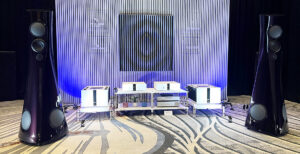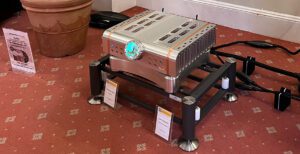
Introduction:
Over the past several years Magnepan made waves by re-vamping its loudspeaker product line from stem to stern, leading to the release of (in ascending order of price and performance) the New MMG, Super MMG System, Mini Maggie System, 1.7, 3.7, and 20.7 loudspeakers. What was (and is) significant about this veritable tsunami of new products is that Magnepan typically does not revise its product line often meaning that there have been instances where models remained in continuous production for well over ten years between new updates.
But what was even more significant about those new models is that, in every single case, they offered—in every single instance—significant leaps forward, relative to their predecessors, in terms of measurable and audible performance, yet without any major increases in pricing. True, the new speakers are a little more expensive than their predecessors, but the increases are so modest and so reasonable as to seem more like “cost of living adjustments” than outright price hikes. It would be fair to say that Magnepan is obsessive about delivering terrific value for money.
In the US, Magnepan’s home market, Magneplanar loudspeakers enjoy an enviable reputation in two parts; first, they are known as outstanding performers in their respective size and price categories, but second, they are widely regarded as some of the greatest values in the entire high-end audio cosmos. Think about it: How often do you find a speaker family known for best-in-class sonic performance, but with down-to-earth pricing so sensible as to qualify as legitimate bargains?
If you asked a group of confirmed high-performance audio enthusiasts which Magnepan model offered the most high-end goodness per dollar (or pound, or Euro), you might get many answers, but my bet is that the lion’s share of responses would name the 3.7 as the sweetest of sweet spots in the lineup, or would have done until now.
Why the “until now” qualifier? The simple answer is that, in a sharp break with past practices, Magnepan has elected to release a newly revised 3.7 model—called the 3.7i, which arrives just three years after the original 3.7 was released (by Magnepan standards, such a rapid revision cycle is without precedent, so that in US-based publications Magnepan ads pose the question: “A new model so soon???”). I’ll be reviewing the 3.7i in Hi-Fi+ in due course, but I wanted to take this opportunity to share some unboxing photos and preliminary comments.
Technical differences between the 3.7i and the 3.7
In a long, free-wheeling, late evening conversation with Magnepan President, Mark Winey, Mr. Winey shared with me one of the key technical differences between the 3.7i and the earlier 3.7. However, no sooner had the information been shared than I was promptly sworn to absolute secrecy on pain of having to swap out my high-end reference audio system for a Bose tabletop radio for all eternity (Please, no, anything but that!!). Sorry, but there is absolutely nothing I can pass along about the innards of the 3.7i. The Magnepan folks prefer to keep the technical details of the 3.71i to themselves and I must respect their decision. I am able, though, to tell you this much:
- The technical changes incorporated in the 3.7i can be retrofitted to existing 3.7-series loudspeakers.
- The 3.7-to3.7i upgrade charge is $500, which is roughly the price differential between the 3.7i ($5,995/pair) and the earlier 3.7 ($5,500/pair). Owners will, of course, be responsible for paying shipping charges to and from the Magnepan factory.
Note: 3.7 owners who are interested in the upgrade must contact Magnepan before returning their speakers to the manufacturer.
- The changes incorporated in the 3.7i are, indeed, readily audible and 100% beneficial, as I’ll explain in a moment.
How big are the sonic improvements in terms of order of magnitude? That question is open to some debate. Many of the US dealers who have heard the 3.7i have reportedly felt the improvements were significant enough to have warranted changing the name to “3.8”—a name that in Magnepan nomenclature would have denoted an all-new model.

Magnepan managers, who have always been and probably always will be modest to a fault, preferred going with the name “3.7i” to denote a model that is plainly improved, but that represents more of an evolution of the existing 3.7 design rather than a full-on new model. You be the judge.
3.7i basics and the unboxing experience
For those of you who have perhaps never seen or heard Magnepan speakers in the flesh, here are some basics you’ll need to know about. The 3.7i is a 71-inch tall, 24-inch wider, and 1.625-inch deep, dipolar planar magnetic loudspeaker (the term “dipolar” means the speaker radiates sound to the front and rear, with the front wave exactly 180-degrees out of phase with the back wave). The 3.7i features a quasi-ribbon-type woofer/midrange panel coupled with a long, slender pure ribbon tweeter. All drivers extend from a few inches above floor level on up to within a few inches of the tops of the speakers.
Thus, the 3.7i behaves (as do other Magnepan models) as a line-source-type loudspeaker, which has performance characteristics very different to a traditional point-source-type loudspeaker. First, the 3.7i offers very even power response from a few inches above floor level on up to just shy of six feet off the ground—and all points in between. Whether you prefer to listen seated on the floor, in a favourite listening chair, or even standing up, the sound of the 3.7i will remain pretty consistent at all plausible elevations (OK, if you’re a freakishly tall basketball player you might not want to listen standing up, but otherwise you should be in fine shape). Second, note that with line-source-type speakers, volume levels do not fall off as sharply as a function of distance as they would do with a point-source-type speaker. As an example, if you listened from, say, a distance of 2 metres from the 3.7i and a point-source speaker, both playing at the same apparent volume levels, and then moved back to a distance of 4 metres, you would find that at the greater distance the 3.7i would be playing at a much higher volume than the point-source speaker at that same distance.
Interestingly, the 3.7i’s are built in mirror-image pairs, which gives end-users two possible placement options. The speakers can be set up with tweeters toward the center, for greater focus and imaging specificity, or with tweeters to the outside, for a larger “sweet spot” and more expansive soundstages. I decided to start out with the tweeters to the inside, but will of course try out both options as my review listening progresses.
The 3.7i ships in two cartons: a large carton that looks like the shipping box for an unusually beefy solid wood door panel (but that in fact contains the two main speaker panels shipped back-to-back with a protective Styrofoam panel sandwiched in between), plus a small carton that contains the speaker’s steel floor stands, installation hardware, and a user’s installation guide. Caution: The larger box is quite heavy (greater than 125 pounds) so if, like me, you have an upstairs listening room you’ll want to have helpers in order to get the speakers up the stairs prior to unboxing. Once in the listening room, it is possible for a single individual to unbox and assemble the 3.7i speakers, though it would be advisable to have a helper on hand.

Installation consists of bolting on the 3.7i’s feet, then installing either a tweeter jumper (or padding resistor, included) in the sockets provided, and then gently and carefully removing a magnetically attached protection plate that covers the ribbon tweeter when the speakers are in transit. Once, those steps are completed, it’s time to place the speakers per Magnepan’s guidelines, connect the speaker cables, and start listening (fine-tuning speaker placement over time to optimize results).

A word about looks: Depending on your own tastes, or those or your significant other, the choice to buy Magnepan’s may or may not be a (visually) controversial one. I’m blessed with a wife who took one look at the 3.7i’s and then said, “Oh, those are really beautiful.” Your mileage may vary. But, here’s a hint: Sometimes, positioning (in the marketing sense of the term) can be everything. My personal experience is that, even among skeptics, it helps to drop an observation to the effect that, “…the Magnepans look rather like classic, Japanese room divider screens, don’t you think?” Somehow, the tall, wide, thin look seems to be easier to embrace, at least for some, if they picture the Maggies as something lovely and graceful (Asian room divider screens, in this case) and not as loudspeakers. Again, your mileage may vary.
First impressions: Magnepan’s new 3.7i
Although I have never owned a pair of the original 3.7s, I have spent many, many hours listening critically to that speaker, so that I base my comments on those prior listening experiences.
First, the 3.7i does everything the 3.7 did: I provides realistic soundstage scale (especially in the height dimension), excellent resolution and focus, truly impressive top-to-bottom coherency, astonishingly good bass energy and extension (especially so for a dipolar loudspeaker), and very good dynamics (assuming you own an amplifier that can put out substantial power into a 4-Ohm load).
What, then, does the 3.7i bring to the party that the 3.7 did not? I would say the difference is one that the ear picks up almost immediately (registering the change on an almost instinctive, “Ahh, that sounds right” level), though it can take a while for the mind to catch up and begin to describe what is different and better, and why. In essence, through the upper midrange and lower treble, the 3.7i sounds noticeably more relaxed and at ease with itself than the 3.7 did. As a consequence, the 3.7i also seems to present a slightly lower noise floor, meaning low-level textural and transient details sound clearer and are easier to hear. Neither of these were areas where the 3.7 seemed flawed, but both are areas where the 3.7i sounds noticeably superior.
Perhaps as a direct result of these improvements, I have so far found that the 3.7i does an unusually good job of creating soundstages so precisely three-dimensional that they seem, at times, almost to wrap around the listener, so that some musical information appears to originate from the sides of the listener (and not just from the front of the listener). Many very high-quality loudspeakers do what I call “wraparound soundstaging” some of the time, but the 3.7i’s do it much more often than most. I don’t really have any technical explanation for why this happens, but I consider it to be one of the speaker’s particular strengths and a characteristic that–on many good recordings–makes for a much more immersive listening experience.
Part of what is so musically satisfying about the jump up to the 3.7i is the fact that the new model now does two good things that, in many competing designs, seem almost mutually exclusive: namely, it sounds more relaxed (which always makes music sound and “feel” more natural), yet it also makes details easier to discern (but with a reduction—not an increase—in perceived brightness and potential edginess). This is precisely the sort of “have your cake and eat it, too” sonic improvement that I find most appealing and my guess is that you will appreciate it, too.
I expect to have an interesting time as I work to tune and refine the speakers’ positioning in my listening room, while also putting some necessary run-in time on the 3.7i’s. I still have much to learn about the speaker and I’ll report my findings (and any discoveries I make along the way) in an upcoming Hi-Fi+ review, which I hope you’ll enjoy when the time comes.
Until then, happy listening.
By Chris Martens
More articles from this authorRead Next From Blog
See all
AXPONA 2024 Show Report Part One
- Apr 19, 2024

Audio Show Deluxe 2024: A photo show report
- Mar 28, 2024

Paul Messenger 1949-2024: A personal tribute
- Mar 26, 2024

Bristol Hi-Fi Show 2024: See You There!
- Feb 21, 2024















